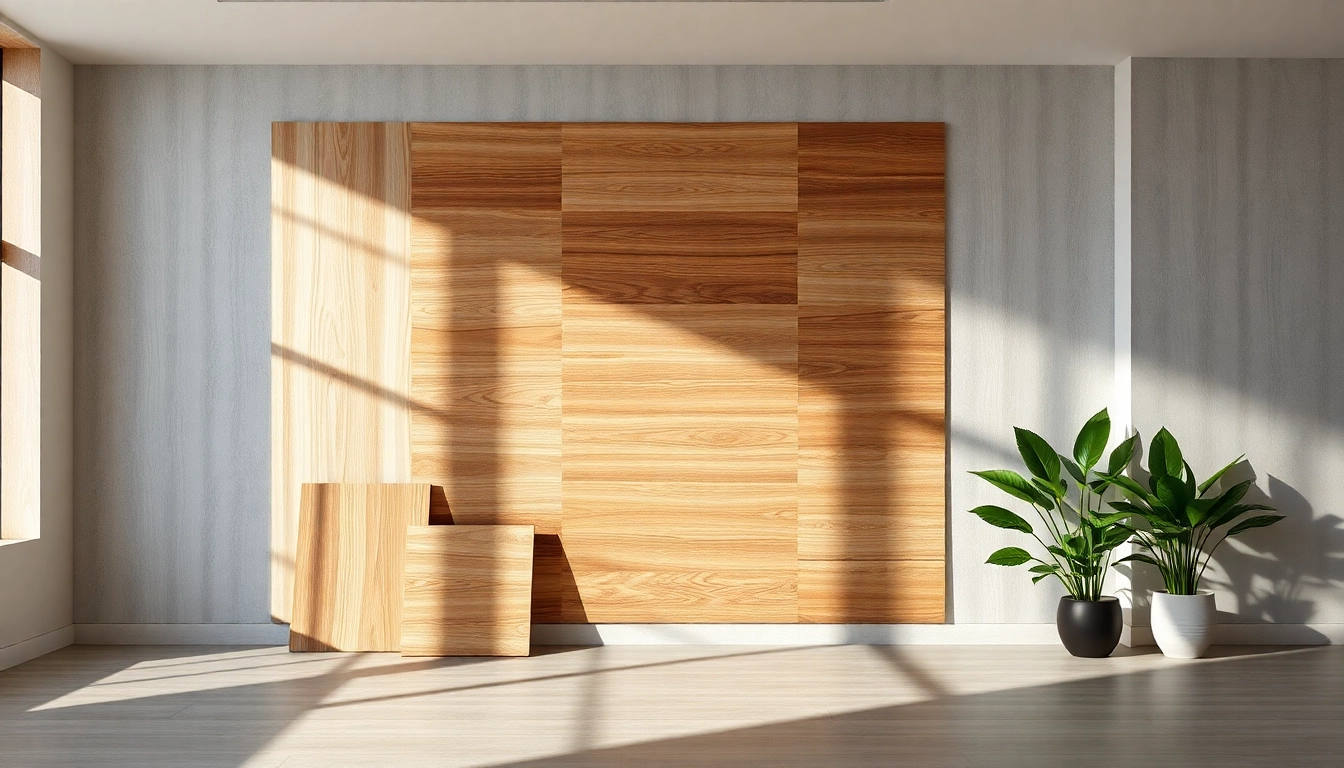Enhancing Spaces with Stylish Paneling Sheets for Modern Interiors

Introduction to Paneling Sheets
Paneling sheets have steadily gained popularity in modern interior design due to their versatility and aesthetic appeal. Used for wall coverings, ceiling decorations, or acoustic solutions, these products can significantly enhance the ambiance of any space. Whether you are renovating a home, designing a commercial space, or simply looking to add a stylish touch, exploring the world of paneling sheets will illuminate various options available to you.
What are Paneling Sheets?
Paneling sheets are typically flat pieces of material used to cover walls or ceilings. They come in various materials, including wood, vinyl, and MDF, and serve both functional and decorative purposes. While traditional paneling may have been associated with dark and heavy wood finishes from previous decades, today’s paneling sheets offer a wide range of styles, colors, and textures. This evolution in design allows for creative freedom that can accommodate any interior aesthetic, from rustic to modern minimalism.
Types of Paneling Sheets
There are several types of paneling sheets that cater to diverse needs and preferences. Understanding these types can help you select the best option for your project:
- Wood Paneling: Classic and warm, wood paneling adds a natural touch to any room. It can be stained or painted to fit various design schemes.
- Vinyl Paneling: Durable and easy to maintain, vinyl paneling is ideal for high-traffic areas. It’s available in numerous finishes, including faux wood and stone.
- MDF (Medium Density Fiberboard) Paneling: This type of paneling is highly versatile, offering a smooth surface that’s perfect for painting. It’s often used in contemporary designs.
- Acoustic Paneling: Specifically designed to absorb sound, acoustic paneling is suitable for theaters, conference rooms, and other spaces needing sound reduction.
- Textured Paneling: These panels feature intricate designs that add depth and character to walls. Available in various materials, they can serve both aesthetic and functional purposes.
Benefits of Using Paneling Sheets
Leveraging paneling sheets in your design scheme comes with an array of benefits:
- Versatility: Paneling sheets can suit any room in your home or office, including living rooms, kitchens, and even bathrooms.
- Ease of Installation: Many contemporary paneling sheets are designed for easy installation, requiring minimal tools and expertise.
- Insulation Properties: Wooden and acoustic paneling sheets can enhance insulation, keeping homes warmer in winter and cooler in summer, thus saving on energy costs.
- Design Statement: Paneling sheets can act as a focal point in a room, showcasing personal taste and elevating the overall aesthetic.
- Durability: High-quality paneling sheets, particularly vinyl and MDF, can withstand wear and tear, making them long-lasting choices.
Choosing the Right Paneling Sheets
Selecting the ideal paneling sheets can seem daunting given the myriad of choices available. By considering specific factors, you can navigate this process with confidence.
Factors to Consider in Selection
When choosing paneling sheets, several key factors should guide your decision:
- Space Usage: Consider what room you are paneling. For instance, moisture-resistant materials are essential for bathrooms, while sound-absorbing panels work best in entertainment areas.
- Style Alignment: Ensure that your paneling choice aligns well with the overall design theme of your space. A sleek, modern look will differ from a cozy, rustic one.
- Budget: Different paneling options vary in price. Determine your budget beforehand to narrow down choices without sacrificing quality.
- Installation Method: Some panels require professional installation, while others are DIY-friendly. Assess your comfort level with home improvement projects when making your choice.
- Maintenance Needs: Different materials require varying levels of care and maintenance. Vinyl, for example, is much easier to clean than wood paneling.
Color and Texture Options
The color and texture of paneling sheets significantly influence the look and feel of a room. Here are some approaches for choosing colors and textures:
- Color Palette: Opt for colors that complement or create a contrast with existing decor. Neutral shades offer versatility, while bold colors can serve as a statement.
- Texture Variety: Think about how textures can enhance visual interest. Smooth finishes may bring a contemporary feel, while rough textures can evoke a rustic ambiance.
- Finish Choices: Consider matte, gloss, or satin finishes to further refine the look. Gloss finishes can highlight textures and create more depth.
Application Scenarios for Paneling Sheets
Understanding where to use the different types of paneling sheets can enhance their impact. Here are some application scenarios:
- Living Rooms: Use decorative wood or textured MDF panels as accent walls.
- Kitchens: Vinyl paneling is perfect for protecting walls against moisture and stains.
- Restaurants: Acoustic paneling can create an inviting atmosphere while reducing noise levels.
- Offices: Consider modern-looking panels for a professional yet approachable aesthetic that promotes productivity.
- Home Theaters: Utilizing acoustic paneling maximizes sound quality while adding a luxurious touch.
Installation Tips for Paneling Sheets
Installing paneling sheets can be straightforward if done correctly. Here are some essential tips to ensure your installation is successful.
Preparation of the Space
Before beginning the installation process, proper preparation is key:
- Measure the Area: Accurately measure the wall or ceiling area to determine how many panels you’ll need.
- Gather Tools: Gather all necessary tools, such as a level, saw, adhesive, and fastening hardware.
- Prepare the Surface: Ensure the surface is clean, dry, and free from dust. Repair any imperfections that could affect adhesion.
Step-by-Step Installation Guide
Follow these general steps for installing paneling sheets:
- Start with Layout: Plan your layout. Use a level to mark straight lines on the wall as guides for panel placement.
- Cut Panels: If required, cut panels to fit your measured dimensions. Always use a saw designated for the panel material.
- Apply Adhesive: Apply paneling adhesive to the back of each sheet, following the manufacturer’s instructions.
- Position Panels: Carefully align and press each panel against the wall, ensuring they’re level and flush with each other.
- Secure Panels: Use nails, screws, or other fasteners if necessary, especially in high-traffic areas.
- Finish Edges: After all panels are in place, trim any excess material at the edges for a completed look.
Common Mistakes to Avoid
To achieve a flawless installation, be aware of these common missteps:
- Ignoring Surface Preparation: A clean surface is crucial for adhesion. Neglecting to prepare can lead to paneling failure.
- Rushing the Process: Take your time with measurement and cutting. Rushed efforts can result in wasted material and an imperfect finish.
- Choosing the Wrong Adhesive: Ensure to use the right adhesive for the material type. Mismatched products can lead to weak adherence.
- Skipping Safety Gear: Always wear protective gear when cutting or handling materials to prevent injuries.
Maintenance of Paneling Sheets
To keep your paneling sheets looking fresh and new, proper maintenance is essential. Here are practical tips to ensure the longevity of your investment.
Cleaning and Care Techniques
Regular cleaning and care can significantly extend the lifespan of your paneling sheets:
- Dust Regularly: Use a soft cloth or vacuum with a brush attachment to remove dust and debris.
- Spot Clean Stains: For stains, use a damp cloth with a mild detergent, gently rubbing affected areas.
- Avoid Harsh Chemicals: Refrain from using abrasive cleaners that can damage the panels’ finish.
Longevity and Durability Considerations
The durability of your paneling sheets will depend on the materials chosen and how they are maintained:
- Wood Paneling: Should be treated with care to avoid warping due to moisture. Regularly check for any signs of damage.
- Vinyl Paneling: While resistant to moisture and easy to clean, they should still be inspected occasionally for fading or wear.
- MDF Paneling: These can be prone to moisture damage; ensuring that they are sealed properly during installation can mitigate this issue.
Troubleshooting Damage or Wear
Even with proper maintenance, wear and tear can occur. Here’s how to address common issues:
- Repairing Scratches: For minor scratches on wood paneling, use a wood filler that matches the stain, followed by a touch-up stain or sealer.
- Fixing Loose Panels: Secure loose panels by applying additional adhesive or using fasteners to reattach them securely.
- Replacing Damaged Panels: If a panel is beyond repair, carefully remove and replace it, following the installation guidelines to match the surrounding panels.
Inspiration and Trends in Paneling Sheets
As interior design continues to evolve, so do the trends surrounding the use of paneling sheets. Here are some current inspirations and what to look forward to.
Current Design Trends
Several design trends have emerged in the realm of paneling sheets:
- Bold Patterns: Geometric and patterned panels are being used to create striking feature walls that grab attention.
- Natural Finishes: A move towards sustainability sees more designers opting for reclaimed wood or environmentally-friendly materials.
- Layering Textures: Combining different materials and finishes creates depth and visual interest within a space.
Showcase of Innovative Paneling Sheets Applications
Paneling sheets have found their way into various innovative applications:
- Interactive Wall Designs: Some designers are integrating LED lighting with paneling sheets for dynamic and responsive installations.
- Multi-Functional Spaces: In small apartments, wall panels often serve as both functional dividers and decorative elements.
- Artistic Expressions: Artists are using paneling to create interactive installations that blend art with architectural elements.
Future of Paneling Sheets in Interior Design
The future of paneling sheets looks promising, with continual innovation in materials and designs:
- Smart Technology Integration: Expect to see paneling that includes integrated technology for enhanced functionality, such as sound systems and smart lighting.
- Sustainability Focus: The trend towards eco-friendly designs will likely lead to more paneling options made from recycled or sustainably sourced materials.
- Customization Options: The personalization of paneling sheets will allow homeowners to create bespoke designs tailored to their particular tastes and needs.



Leave a Comment